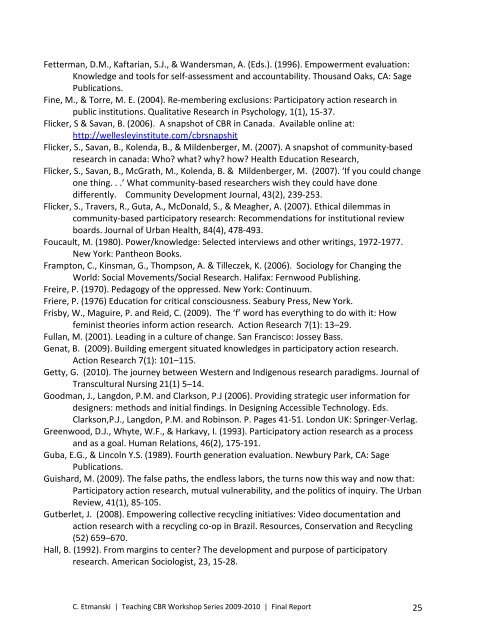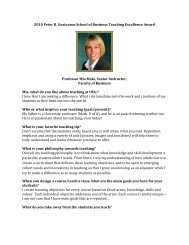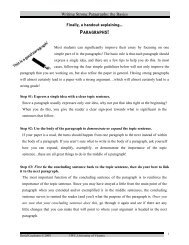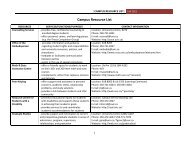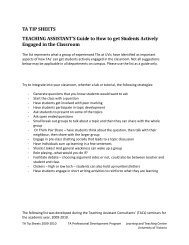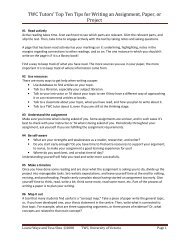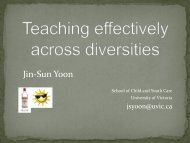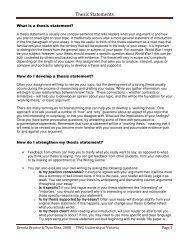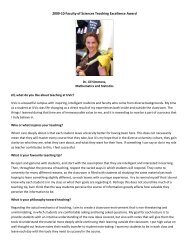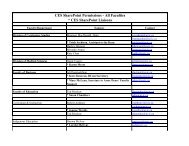C. Etmanski, Teaching CBR 2009-10 Workshop Series Final Report
C. Etmanski, Teaching CBR 2009-10 Workshop Series Final Report
C. Etmanski, Teaching CBR 2009-10 Workshop Series Final Report
- No tags were found...
You also want an ePaper? Increase the reach of your titles
YUMPU automatically turns print PDFs into web optimized ePapers that Google loves.
Fetterman, D.M., Kaftarian, S.J., & Wandersman, A. (Eds.). (1996). Empowerment evaluation:Knowledge and tools for self-assessment and accountability. Thousand Oaks, CA: SagePublications.Fine, M., & Torre, M. E. (2004). Re-membering exclusions: Participatory action research inpublic institutions. Qualitative Research in Psychology, 1(1), 15-37.Flicker, S & Savan, B. (2006). A snapshot of <strong>CBR</strong> in Canada. Available online at:http://wellesleyinstitute.com/cbrsnapshitFlicker, S., Savan, B., Kolenda, B., & Mildenberger, M. (2007). A snapshot of community-basedresearch in canada: Who? what? why? how? Health Education Research,Flicker, S., Savan, B., McGrath, M., Kolenda, B. & Mildenberger, M. (2007). ‘If you could changeone thing. . .’ What community-based researchers wish they could have donedifferently. Community Development Journal, 43(2), 239-253.Flicker, S., Travers, R., Guta, A., McDonald, S., & Meagher, A. (2007). Ethical dilemmas incommunity-based participatory research: Recommendations for institutional reviewboards. Journal of Urban Health, 84(4), 478-493.Foucault, M. (1980). Power/knowledge: Selected interviews and other writings, 1972-1977.New York: Pantheon Books.Frampton, C., Kinsman, G., Thompson, A. & Tilleczek, K. (2006). Sociology for Changing theWorld: Social Movements/Social Research. Halifax: Fernwood Publishing.Freire, P. (1970). Pedagogy of the oppressed. New York: Continuum.Friere, P. (1976) Education for critical consciousness. Seabury Press, New York.Frisby, W., Maguire, P. and Reid, C. (<strong>2009</strong>). The ‘f’ word has everything to do with it: Howfeminist theories inform action research. Action Research 7(1): 13–29.Fullan, M. (2001). Leading in a culture of change. San Francisco: Jossey Bass.Genat, B. (<strong>2009</strong>). Building emergent situated knowledges in participatory action research.Action Research 7(1): <strong>10</strong>1–115.Getty, G. (20<strong>10</strong>). The journey between Western and Indigenous research paradigms. Journal ofTranscultural Nursing 21(1) 5–14.Goodman, J., Langdon, P.M. and Clarkson, P.J (2006). Providing strategic user information fordesigners: methods and initial findings. In Designing Accessible Technology. Eds.Clarkson,P.J., Langdon, P.M. and Robinson. P. Pages 41-51. London UK: Springer-Verlag.Greenwood, D.J., Whyte, W.F., & Harkavy, I. (1993). Participatory action research as a processand as a goal. Human Relations, 46(2), 175-191.Guba, E.G., & Lincoln Y.S. (1989). Fourth generation evaluation. Newbury Park, CA: SagePublications.Guishard, M. (<strong>2009</strong>). The false paths, the endless labors, the turns now this way and now that:Participatory action research, mutual vulnerability, and the politics of inquiry. The UrbanReview, 41(1), 85-<strong>10</strong>5.Gutberlet, J. (2008). Empowering collective recycling initiatives: Video documentation andaction research with a recycling co-op in Brazil. Resources, Conservation and Recycling(52) 659–670.Hall, B. (1992). From margins to center? The development and purpose of participatoryresearch. American Sociologist, 23, 15-28.C. <strong>Etmanski</strong> | <strong>Teaching</strong> <strong>CBR</strong> <strong>Workshop</strong> <strong>Series</strong> <strong>2009</strong>-20<strong>10</strong> | <strong>Final</strong> <strong>Report</strong> 25


